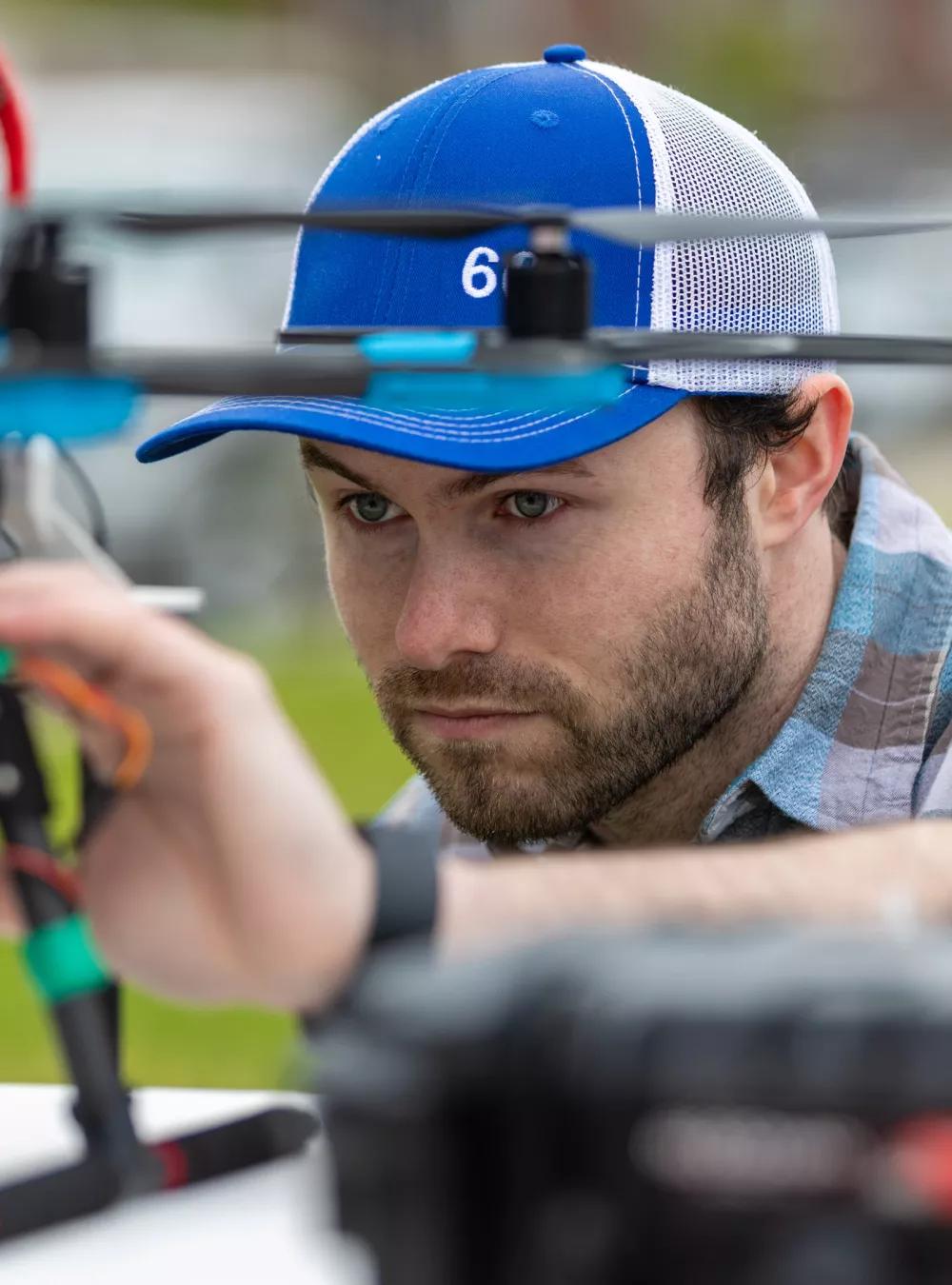The New York City Police Department (NYPD) and New York City Fire Department (FDNY) are helping MITRE create and test a new system that transforms small drones into hazardous response units to protect first responders and the public they serve.

FDNY and NYPD Help Test MITRE's Latest UAS Innovation
ABOVE: MITRE's innovation transforms commercial drones into specialized hazmat units able to bring sensors to the scene without risking safety. (Photo: Joshua Gottschling, MITRE)
Over three billion tons of hazardous materials are shipped across the United States every year. Threats of chemical, biological, nuclear, or explosive terrorism are rising. When most spills, accidents, or incidents occur, it's first responders who investigate and provide on-scene assessments of the risk.
The scenario is familiar to MITRE project lead Steve King. When not at the office, King volunteers as a firefighter and paramedic and previously worked as a hazmat team commander and fire marshal in the City of Manassas Park, Virginia. He knows drones (also called uncrewed aircraft systems, or UAS) can help in dangerous situations, capturing visuals and air quality samples so humans don’t have to.
Yet, specialized hazmat UAS are cost-prohibitive for cities like Manassas Park, and makeshift solutions can be difficult to control. First responders need a creative, cost‑effective solution that is adaptable, affordable, and as functional in the fields of Wyoming and East Palestine, Ohio, as the crystal canyons of Manhattan.
So, in keeping with other solutions we’ve developed to aid and empower first responders, MITRE created one.
We want to make something that’s really purpose-built for and with the emergency response teams that use it.
Our technology transforms any UAS into a hazardous materials response unit. A 3D printable articulating arm, which can be attached to any drone or robotic device, safely carries chemical, biological, radiological, nuclear, or explosive material sensors without limiting the drone’s movement.
When combined with MITRE's long-range, low-power digital communications tool, it translates hazardous material-sensor data into real-time threat awareness. And it does all this without risking human lives.
“This new sensor-integration and communications capability highlights how we’re bringing innovation to the first responder community and homeland security enterprise,” says Yosry Barsoum, vice president and director for MITRE’s Center for Securing the Homeland.
“Our first responders are on the front line of homeland security. This work is crucial to protect our people during hazardous material emergencies,” he continues.
“Part of MITRE's mission is to understand the operational environment, connect government needs with industry solutions, and solve whole-of-nation problems.”
In late April, under the watchful eyes of representatives from FDNY Robotics, NYPD’s Emergency Services Unit, and the NYPD Technical Assistance Response Unit, our hazmat sensor system took flight.
Making Hazmat Response Safer and More Effective
New York City is a challenging place for drones. The winds are brutal. There’s little room to maneuver, and the electromagnetic spectrum that drones use to operate is packed with overlapping broadcasts. If MITRE’s technology could succeed here, it could succeed (almost) anywhere.
The utility of UAS is already well known in the city. The NYPD owns 14 drones providing overwatch capabilities during barricade situations or while search warrants are served. FDNY Robotics estimates they’ve sent drones on almost a thousand missions with hundreds of hours of flight time in the last few years.
When a recent parking garage collapse in Lower Manhattan proved too dangerous for emergency responders, FDNY used drones to survey the scene. “We're able to use the technology to get information and reconnaissance without putting our firefighters' lives and our first responders' lives at risk,” NYC Fire Chief John Esposito said in a press conference about the incident.
Adding the ability to detect hazardous material and relay the information to the commander directly would be game-changing. “It’s cheaper, faster, and safer to use a properly equipped drone in a hazmat situation than it is to put someone in a suit, send them into the area, and then decontaminate that suit,” one demonstration participant said.
Responders envision connecting MITRE's real-time data communication feed to mapping software and other response-planning programs to provide a better overall view of potential incidents.
A System Built For and With First Responders
As cold winds blew off the East River this spring, the drone flew along searching for a quarter-sized disc of radioactive material hundreds of yards away. Later, operators piloted it through the corridors of an abandoned building to show how the system could detect and communicate readings and share data even through the thick walls and crowded radio landscape of New York City.
The team also transferred the system onto one of NYPD’s own quadcopter drones, highlighting the flexibility and adaptability built into the design.
This demonstration did more than just kick the tires on our prototype. It gave first responders and MITRE engineers the ability to create something together.
“We want to make something that’s really purpose-built for and with the emergency response teams that use it,” King says. “You can’t do that without talking to them, showing them how the system works, and making sure it aligns with their needs.”
When finished, our team intends to freely offer the system plans to departments around the country as part of our public service mandate. Since it’s made of common commercial components, this means departments everywhere could have access to the technology. Adapting existing systems for a few hundred dollars would save first-responder organizations and teams the high cost of specialized drones—proving especially valuable for smaller and more-rural departments.
“We're excited to offer these teams some cutting-edge technology so they can respond more safely and much more quickly,” King says.
“That's really going to save lives.”
Join our community of innovators, learners, knowledge-sharers, and risk-takers. View our Job Openings.